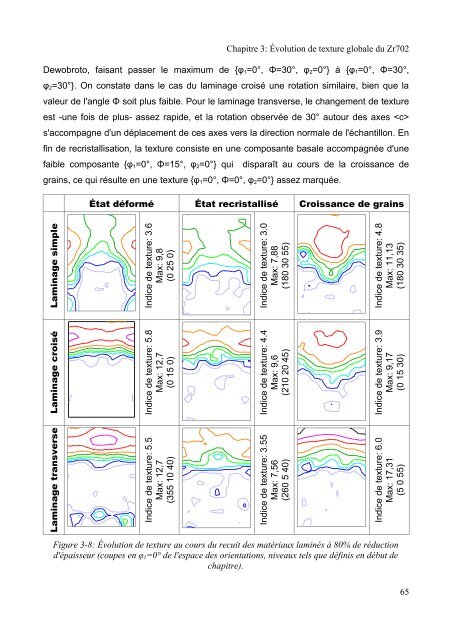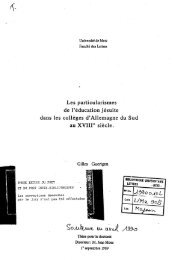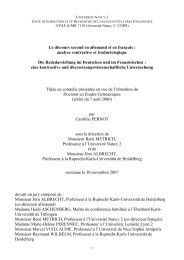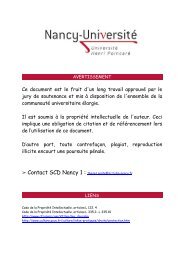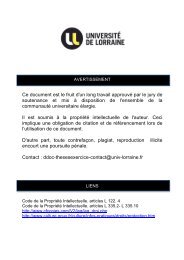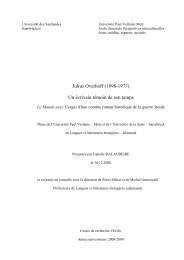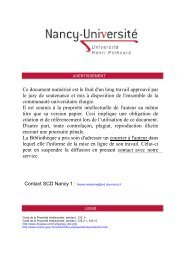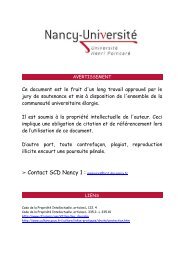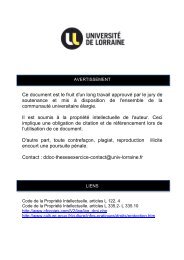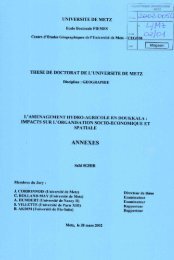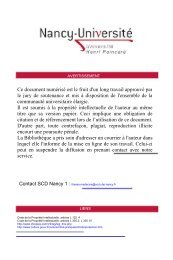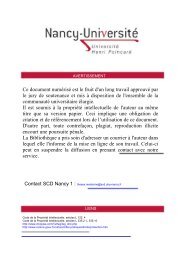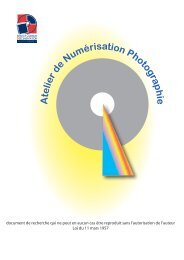Mécanismes d'évolution de texture au cours du recuit d'alliages de ...
Mécanismes d'évolution de texture au cours du recuit d'alliages de ...
Mécanismes d'évolution de texture au cours du recuit d'alliages de ...
Create successful ePaper yourself
Turn your PDF publications into a flip-book with our unique Google optimized e-Paper software.
Chapitre 3: Évolution <strong>de</strong> <strong>texture</strong> globale <strong>du</strong> Zr702<br />
Dewobroto, faisant passer le maximum <strong>de</strong> {φ1=0°, Φ=30°, φ2=0°} à {φ1=0°, Φ=30°,<br />
φ2=30°}. On constate dans le cas <strong>du</strong> laminage croisé une rotation similaire, bien que la<br />
valeur <strong>de</strong> l'angle Φ soit plus faible. Pour le laminage transverse, le changement <strong>de</strong> <strong>texture</strong><br />
est -une fois <strong>de</strong> plus- assez rapi<strong>de</strong>, et la rotation observée <strong>de</strong> 30° <strong>au</strong>tour <strong>de</strong>s axes <br />
s'accompagne d'un déplacement <strong>de</strong> ces axes vers la direction normale <strong>de</strong> l'échantillon. En<br />
fin <strong>de</strong> recristallisation, la <strong>texture</strong> consiste en une composante basale accompagnée d'une<br />
faible composante {φ1=0°, Φ=15°, φ2=0°} qui disparaît <strong>au</strong> <strong>cours</strong> <strong>de</strong> la croissance <strong>de</strong><br />
grains, ce qui résulte en une <strong>texture</strong> {φ1=0°, Φ=0°, φ2=0°} assez marquée.<br />
Laminage simple<br />
Laminage croisé<br />
Laminage transverse<br />
État déformé État recristallisé Croissance <strong>de</strong> grains<br />
Constant Phi1 = 0 Constant Phi1 = 0 Constant Phi1 = 0<br />
Indice <strong>de</strong> <strong>texture</strong>: 3.6<br />
Max: 9,8<br />
(0 25 0)<br />
Indice <strong>de</strong> <strong>texture</strong>: 5.8<br />
Max: 12,7<br />
(0 15 0)<br />
Indice <strong>de</strong> <strong>texture</strong>: 3.0<br />
Max: 7,88<br />
(180 30 55)<br />
Constant Phi1 = 0 Constant Phi1 = 0 Constant Phi1 = 0<br />
Indice <strong>de</strong> <strong>texture</strong>: 5.5<br />
Max: 12,7<br />
(355 10 40)<br />
Indice <strong>de</strong> <strong>texture</strong>: 4.4<br />
Max: 9,6<br />
(210 20 45)<br />
Constant Phi1 = 0 Constant Phi1 = 0 Constant Phi1 = 0<br />
Indice <strong>de</strong> <strong>texture</strong>: 3.55<br />
Max: 7,56<br />
(260 5 40)<br />
Indice <strong>de</strong> <strong>texture</strong>: 4.8<br />
Max: 11,13<br />
(180 30 35)<br />
Indice <strong>de</strong> <strong>texture</strong>: 3.9<br />
Max: 9,17<br />
(0 15 30)<br />
Indice <strong>de</strong> <strong>texture</strong>: 6.0<br />
Max: 17,31<br />
(5 0 55)<br />
Figure 3-8: Évolution <strong>de</strong> <strong>texture</strong> <strong>au</strong> <strong>cours</strong> <strong>du</strong> <strong>recuit</strong> <strong>de</strong>s matéri<strong>au</strong>x laminés à 80% <strong>de</strong> ré<strong>du</strong>ction<br />
d'épaisseur (coupes en φ1=0° <strong>de</strong> l'espace <strong>de</strong>s orientations, nive<strong>au</strong>x tels que définis en début <strong>de</strong><br />
chapitre).<br />
65


